Neither rain, sleet, snow or below freezing temps the night before could stop the WICOLA water monitoring team from going out at 8:15 am today to complete the first of six monthly water monitoring / testing excursions on our chain. They were wrapped up ready for the cold temps...but fortunately the sun came out once the team hit the water!!
White Iron Chain Of Lakes Association
To stay informed about the current water level elevations, flow, and conditions, please check the Minnesota Power webpage at;
http://web15.mnpower.com/web/public/Hydro/ShorelandTraditions/Levels.html
And the USGS stream flow report covering the inflow to Birch Lake Reservoir at;
http://waterdata.usgs.gov/mn/nwis/uv/?site_no=05125000&PARAmeter_cd=00065,00060
White Iron Lake, Farm Lake, Garden Lake
Some stubborn lingering ice remains is some bays and isolated areas. Most of the lake is ice free so the unofficial call is that the ice is out.
Other Area Lake Reports
Robinson, Clear Lake & Armstrong are all out.
Wildfires often begin unnoticed. These fires are usually triggered by lightning or accidents, igniting brush, trees, and homes. They spread quickly, especially with the current extreme conditions we are facing in Lake and St. Louis Counties due to a combination of high winds, warm temperatures, low humidity and little significant rain in the forecast until Sunday (4/19). Reduce your risk by preparing now - before a wildfire strikes.
There are critical steps to follow “Before”, “During”, and “After” to protect your family, home, and property. To learn more and to become better prepared, go to; www.ready.gov/wildfires and click on the Before, During, and After Tabs.
White Iron Lake
Although the area between the ring rock points was iced in part 24 hours ago, as of noon today (4/15) it is open all the way across and the high winds continue to erode the ice quickly. There is a large open area off the boat ramp on South White Iron road and it extends up to the narrows at the ring rock points. Ice on both the East and West ends continues to deteriorate quickly.
View from White Iron Lake near the Ring Rock Points
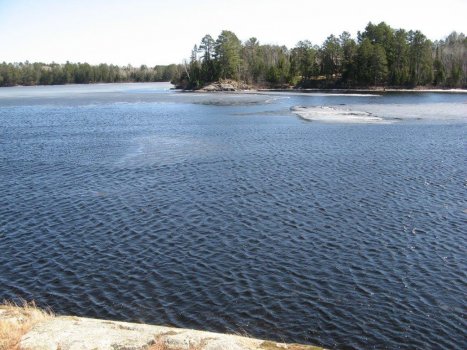
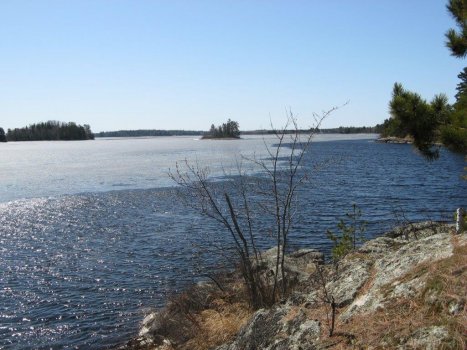
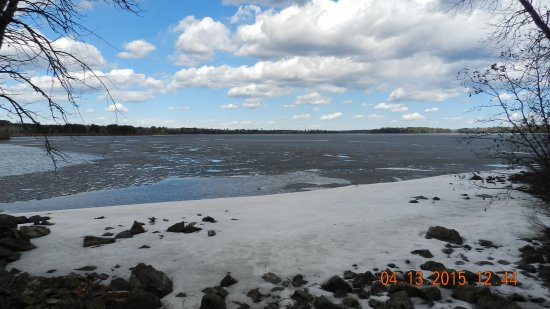
White Iron Lake
Some shoreline areas have a small amount of open water depending on location and wind direction. Several bays that are shallow are also becoming ice free. Today the ice between the ring rocks is about 25% open and the ice looks only a couple inches deep…Yesterday it looked close to 6”. There are now major cracks in the ice and several of the pieces are shifting and grinding together. The main lake ice on both the East and West ends of the lake is very black and deteriorating quickly, especially with the warm weather and winds this past weekend...lake should be open in a few days.
Farm Lake
The ice along the shorelines is opening enough for the buffleheads to swim and dive and in the middle of the lake there is a large opening where seagulls and ducks are swimming. The ice is turning black and is rotten in a lot of places which means if these temperatures, wind and sun continue with night temps hovering above freezing for the rest of the week, ice will be gone.
Garden Lake
There is still no open water except small areas around the shoreline. Across the lake, where the Kawishiwi River flows through Garden, there is still ice. With the ice turning black, high winds and warmer temps, expect to see some open water soon. At the Fernberg Bridge, there is open water about 50 yards upstream where Garden Lake flows toward the dam.
Birch Lake
The ice is turning black, won’t be long until ice out.
Join us for a training session at Vermillion Community College at 3:30 PM on Wednesday April 22nd (Earth Day). We will be reviewing the procedures for conducting Citizen Stream Monitoring, Citizen Lake Monitoring as well as the sampling procedures for water sampling to monitor for nutrients. We will also be reviewing sampling protocols, chain of custody forms and sonde calibration, maintenance, and proper use.
This training is open to any WICOLA member interested in helping with water monitoring from May-September as well as to any member who just wants to learn more about Water Monitoring.
For further information or questions, please contact Nancy Powers
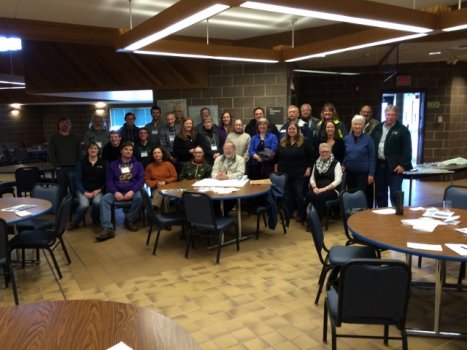 On March 12, WICOLA Members, Nancy Powers and Teresa Sagen, joined a group of about 30 people at Vermilion Community College to address invasive species and sustainable landscapes in Northern Minnesota. The workshop was organized by Ely Field Naturalists, Superior National Forest, and the 1854 Treaty Authority. The workshop was led by representatives from The Stewardship Network, located in Lansing, MI, and focused on the strength of working together as a Collaborative Conservation Community for a more collective impact. Individuals and organizations represented at the workshop will continue to explore the potential for forming a CCC. The Stewardship Network is a national award-winning conservation group with the purpose of connecting, equipping and mobilizing people and organizations to care for land and water. For more information and resources, check out The Stewardship Network website at www.stewardshipnetwork.net
On March 12, WICOLA Members, Nancy Powers and Teresa Sagen, joined a group of about 30 people at Vermilion Community College to address invasive species and sustainable landscapes in Northern Minnesota. The workshop was organized by Ely Field Naturalists, Superior National Forest, and the 1854 Treaty Authority. The workshop was led by representatives from The Stewardship Network, located in Lansing, MI, and focused on the strength of working together as a Collaborative Conservation Community for a more collective impact. Individuals and organizations represented at the workshop will continue to explore the potential for forming a CCC. The Stewardship Network is a national award-winning conservation group with the purpose of connecting, equipping and mobilizing people and organizations to care for land and water. For more information and resources, check out The Stewardship Network website at www.stewardshipnetwork.net
Northshore mining has proposed an expansion of its Peter Mitchell Mine in Babbitt that has the potential for future impacts on the Kawishiwi Watershed, including WICOL. Environmental organizations have requested a full (state) Environmental Impact Statement from the lead agency, MN DNR. Although DNR had promised a response by January 27, no statement has been issued. Similar requests have been made to the Minnesota Pollution Control Agency and the federal Environmental Protection Agency which must issue permits for the mine expansion to proceed.
The Peter Mitchell Mine produces taconite ore. The primary issue concerns the approximately 15 foot overburden of sulfide ore rock that must be removed and stored to reach the taconite deposit. Sulfide bearing rock, when exposed to air and water, produces the toxic waste found in copper nickel mine operations. The current EAW for the project contains no agency requirements to protect the disposed rock from water and air, and to treat discharges should water seepage occur. Nor have agencies provided information on potential fractures in the bedrock of the storage site. The mine and waste storage sites currently drain into both the Rainy River Basin / Kawishiwi Watershed, and into the Lake Superior Basin.
Additional information can be obtained from:
Minnesota DNR website, www.dnr.state.mn.us – environmental review – projects – Northshore Mining
Mining Company, www.cliffsnaturalresources.com – Northshore Mining
An environmental organization, www.waterlegacy.org – Northshore Mine
Think of the last time you planned a visit to a lake. Why did you choose the lake you did? Did you consider the quality of the water? The answers to these questions are critical to understanding how lake users make decisions about their recreation choices and the value society places on water resources.
New research published in Frontiers in Ecology and the Environment presents a novel approach to calculating the value of clean water. Analyzing photos posted to the online photo-sharing site Flickr, researchers at the Natural Capital Project and Iowa State University found Minnesota and Iowa lakes with greater water quality receive more visits than dirtier lakes, and that users are willing to travel farther to visit those clean, clear lakes.
The traditional approach to gathering Lake Visitation data would be through expensive and time-consuming surveys, asking people where they recreate and why. In this study, the researchers used online photographs taken of lakes that were uploaded to Flickr and could easily be analyzed with minimal expense. The researchers used this information, along with spatial analysis techniques and models, to estimate the values users place on lakes.
“The photos tell us a story about what lakes people prefer, where they live, and how far they travel to visit different lakes” said Bonnie Keeler, co-author and lead scientist with the Natural Capital Project at the University of Minnesota’s Institute on the Environment.
As the authors note, there are many lakes and rivers that are impaired and efforts to restore or improve water quality can be expensive. This study offers one approach to capturing the value of water quality improvements — information that can inform cost benefit assessments and better targeting of restoration investments. The study is also valuable because it underscores the potential for social-media data to inform social–ecological research.
The Natural Capital Project is a partnership combining research innovation at the University of Minnesota’s Institute on the Environment and Stanford University with the global reach of conservation science and policy at The Nature Conservancy and the World Wildlife Fund.
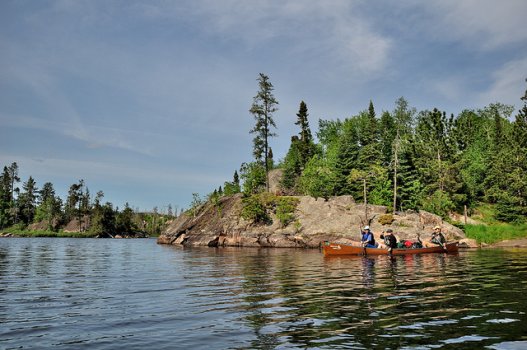
The International Joint Commission (IJC) strongly recommends that the governments of Canada and the United States undertake all 32 projects identified in the final Plan of Study it has delivered to them to address the complex water quality challenges facing the Lake of the Woods Basin.
In the summer of 2012, both governments agreed to the development of a water quality plan of study for the Basin, which was recommended in the Commission’s January 2012 “Report to the Governments of the United States and Canada on Bi-national Water Management of the Lake of the Woods and Rainy River Watershed.”
“The Plan was prepared by a binational Study Team at the direction of the IJC and is based on extensive engagement with public agencies, scientific and technical experts, community groups, First Nations, Métis and Tribes and the general public,” added U.S. Chair, Lana Pollack. “It also follows two periods of public review and feedback, and builds upon considerable cooperative work and planning that has been undertaken in the basin in recent years.”
The Plan of Study identifies five themes of concern, and strongly recommends funding for 32 projects and activities to support a balanced approach to water quality management, in response to concerns by governments, researchers, local residents and indigenous peoples about the Basin’s ecosystem health.
1. Monitoring – 1 project to provide long-term, consistent data to track trends in nutrients, contaminants and aquatic invasive species. The Commission identified this project as a priority.
2. Nutrient enrichment and harmful algal blooms – 11 projects to improve their management, reduce their severity and frequency, as well as the risks associated with the algal toxins they can release
3. Aquatic invasive species – 7 projects to strengthen ongoing prevention measures and pursue control efforts to curb the negative effects of the many invasive species now residing in the Basin
4. Surface and groundwater contamination – 7 projects to better understand contamination sources, assess the vulnerability of water resources and establish protective measures
5. Capacity building – 6 projects to engage all Basin interests on water quality management and promote greater cooperation among agencies working in it
The Plan also recommends four projects for immediate action to address significant, pressing risks to the Basin’s ecosystem health:
· International Platform for Implementation. This project is crucial to the successful implementation of the Plan of Study and future binational management opportunities.
· Rapid Evaluation and Implementation of Options to Manage Recent Zebra Mussel Infestation in Headwaters Areas in Minnesota. Zebra mussels pose a significant, immediate risk to the ecosystem health of the Basin.
· Long-term Funding of Wheeler’s Point Gage and Designation as a Gage of Binational Significance. This is a critical component for determining ecosystem health in the Basin.
· Implementation of Proven Best Management Practices (BMPs) and Removal of Solids from Effluent. Where BMPs have been identified as effective at reducing nutrient loads from agricultural lands, they should be implemented immediately. Effluent from sewage and wastewater treatment facilities is an important source of nutrients that can impact lakes and rivers. An immediate action to reduce nutrients would be to enhance the capacity of treatment facilities to reduce solids.
For more information, please contact;
Dominique Guerin-Garnett Frank Bevacqua
Ottawa, ON Washington, D.C.
613-947-1420 202-736-9024
Links:
Report on Bi-National Water Management of the Lake of the Woods – Rainy River Watershed
International Lake of the Woods Basin Water Quality Plan of Study, January 2015
DNR NEWS – FOR IMMEDIATE RELEASE Jan. 28, 2015
The Minnesota Department of Natural Resources will postpone the new aquatic invasive species training and trailer decal program that was due to launch at the end of the month while legislators consider changes to the program.
Under a law passed by the state Legislature in 2012, anyone trailering a boat or water-related equipment such as docks and lifts in Minnesota is required to take aquatic invasive species training and display a decal on their trailer. The effective date is July 1, 2015.
“With the legislative interest in this educational program and ongoing discussions about possible changes, we are postponing the launch until we see if the Legislature acts this session to modify the program,” said Bob Meier, DNR assistant commissioner.
The DNR supports the education that would be provided under this law, but recognizes there are some concerns with the way the law is currently written. For example, people transporting boats on trailers through Minnesota to another destination are required to take the course and display a decal even if they don’t put their boat in Minnesota waters.
Since the training and decal are currently not required until July 1, the DNR wants to remind people that there will be time to see what happens legislatively and still take the course and receive decals. The agency will post any updates on trailers at www.trailers.mndnr.gov and alert the media if there are any program changes.
Minnesota lakes and rivers are among the state’s greatest natural assets. Yet aquatic invasive species (AIS) today threaten the quality of these legacy resources for the enjoyment of future generations. Preventing and limiting the spread of these aquatic invaders is critical to the future of Minnesota’s water resources.
Larry Thomforde, WICOLA AIS Coordinator, recently attended the Aquatic Invaders Summit Conference in St. Cloud on January 20-21. In addition to Larry, the Ely area was well represented. St Louis and Lake Counties sent delegations as well as the lake association from Burntside Lake. In total, over 400 people attended the conference, including our downstream neighbors in Canada.
Minnesota has pledged to aggressively fight the spread of AIS with $10 million annually in prevention aid to counties which, working with their local partners, will plan and implement programs to prevent and limit the spread of aquatic invasive species.
The conference provided an opportunity for Larry to hear about the biology of aquatic invasive species and also learn about measures of prevention and treatment. Much of the conference was devoted to listening to the counties and lake associations which have already implemented prevention and treatment measures, tell about the successes and failures they have experienced. This part of the conference was particularly valuable as the border lake counties continue to expand a program to fight the spread of AIS.
An after conference hours meeting was convened by the representatives of the Rainy River - Headwaters Watershed. This included representatives from Beltrami, Cook, Itasca, Koochihing, Lake of the Woods, St Louis, Lake and Roseau counties, the Minnesota DNR, Lake Superior Sea Grant, Lake of the Woods International Watershed Coordinator Kelli Saunders, Lake County Commissioner Rich Sve and the Burntside and White Iron Chain of Lakes. This group shared thoughts and ideas that will help coordinate an AIS watershed plan that is in the best interest of our waterway and has the best chance of success.
By Teresa Sagen
The International Lake of the Woods Basin Water Quality Plan of Study is available for review and comment for a 30-day period, from November 12 to December 11, 2014. The International Joint Commission (IJC) wants to hear from us and others covered in the plan before submitting its recommendations to the Governments of Canada and the United States. This Plan comes as a result of a period of public meetings, including one attended by many WICOLA members and Ely area residents at VCC in August. Please review the Plan and offer your comments as a WICOLA member to ensure the continued focus on prevention and preservation of our clean waters. Copies of the Plan of Study (1 Meg) can be downloaded at: http://ijc.org/files/tinymce/uploaded/documents/LOWBPOS%20Nov%2012%202014_1.pdf. Comments may be submitted electronically at: http://www.ijc.org/en_/LOWWQPOS
by Jo Kovach - President
At the beginning of 2014 your WICOLA Board set the following priorities:
1.Continue water quality monitoring, expand the volunteer base and tell others how to do this. Completed. All planned monitoring accomplished, full slate of volunteers trained, two lake associations assisted.
2.Follow-up on the septic information collected by KWPP. Completed. Results of e.coli testing reported in the Fall 2014 newsletter.
2a. Create One Community Assessment Report which would yield individual inspections of septic system. Not Completed, but in process. The area where this could be beneficial has been narrowed down.
3.Continue to focus on AIS. Completed. Crayfish trapping expanded, additional public education on Rusties and Spiny Water Flea; Testing Ca (Calcium) levels showed that zebra mussels are unlikely in our lakes.
4.Education regarding shoreline management. Progress on the related issue of education of property owners regarding guidelines for safeguarding their properties from wildfire.
5.Also added a 5th priority of beginning to address the issue of maintaining clean water in the face of plans for copper nickel mining in our watershed.
WICOLA volunteers finished the water monitoring season on a cool, 42 degree morning in September. Thanks to all volunteers who have done water monitoring and E.coli testing on WICOL and surrounding lakes this season.
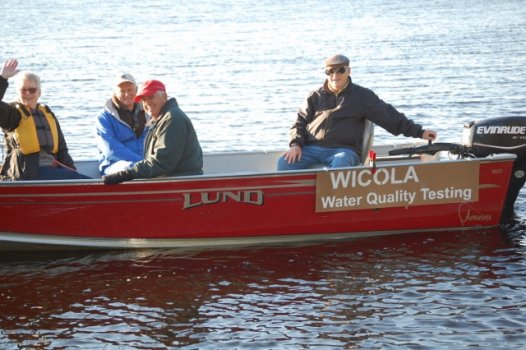
WASHINGTON — The U.S. Environmental Protection Agency will hold its second annual SepticSmart Week September 22-26. SepticSmart Week outreach activities encourage homeowners and communities to care for and maintain their septic systems. Nearly one-quarter of all American households depend on septic systems to treat their wastewater.
Failure to maintain septic system can lead to back-ups and overflows that pollute local waterways, create dead zones, raise water treatment costs and endanger human health. Pollutants such as nitrogen, phosphorus and fecal bacteria can enter ground and surface waters from septic systems. Such pollutants affect drinking water, lakes, rivers and estuaries. The algal blooms they may generate can produce toxins harmful to human, animals and marine life.
Data collected by states attribute septic systems and other onsite wastewater treatment methods to water quality impairments in 22,909 miles of rivers and streams; 199,995 acres of lakes, reservoirs and ponds; and 72,320 acres of wetlands. By properly maintaining their septic systems, homeowners can help reduce these numbers.
“When homeowners protect their septic systems, it’s good for their health, their neighbors’ health, and their pocketbooks,” said Ken Kopocis, Deputy Assistant Administrator in EPA’s Office of Water. “Not only is EPA directly educating homeowners on septic maintenance, but we are also coordinating with states and municipalities to do the same.”
During SepticSmart Week, EPA will provide homeowners with tips for septic maintenance, including:
- Protect It and Inspect It: Homeowners should generally have their system inspected every three years by a licensed contractor, and have their tank pumped when necessary, typically every three to five years. Many septic system failures occur during the winter holiday season. Therefore, EPA encourages homeowners to get their septic systems inspected and serviced now before licensed inspectors’ schedules fill up around the holidays.
- Think at the Sink: Avoid pouring fats, grease and solids down the drain. These substances can clog a system’s pipes and drainfield. · Don’t Overload the Commode: Only put things in the drain or toilet that belong there. For example, coffee grounds, dental floss, disposable diapers and wipes, feminine hygiene products, cigarette butts and cat litter can all clog and potentially damage septic systems.
- Don’t Strain Your Drain: Be water efficient and spread out water use. Fix plumbing leaks and install faucet aerators and water-efficient products. Spread out laundry and dishwasher loads throughout the day — too much water at once can overload a system that hasn’t been pumped recently.
- Shield Your Field: Remind guests not to park or drive on a system’s drainfield, where the vehicle’s weight could damage buried pipes or disrupt underground flow.
EPA’s SepticSmart program educates homeowners about proper septic system care and maintenance all year long. In addition, it serves as an online resource for industry practitioners, local governments and community organizations, providing access to tools to educate clients and residents.
For more information, visit: www.epa.gov/septicsmart
Unfortunately, Basswood Lake joins the list of area lakes (Burntside, Shagawa, Fall, Vermilion) infested with Spiny Waterfleas. Be aware that lakes, such as Crooked Lake, Iron Lake, and Bottle Lake, are downstream of Basswood and are susceptable to infestation since there is no physical barrier between these lakes and Basswood Lake. We need to be particular diligent to prevent the further spread of Spiny Waterfleas and other AIS to other lakes and particular to the White Iron Chain of Lakes. What can you do? Be informed and follow the recommended steps for prevention. Go to the DNR site http://www.dnr.state.mn.us/invasives/index.html for more information about AIS and prevention.
A packed house attended the 21st annual meeting of WICOLA on Thursday, August 7. Known for a long history of monitoring water quality in White Iron, Farm, and Garden Lakes, association members quickly adopted a potentially contentious resolution with an overwhelming majority of votes both present and by proxy:
"WICOLA, as a steward of the White Iron Chain of Lakes, will closely review the plans of Twin Metals and other proposed projects that potentially degrade our water environment and will act to promote clean water. WICOLA is committed to preserving the high water quality of the unique watershed we inhabit. We embrace the federal and state requirements that our chain of lakes, which flow into the BWCAW, remains pure and unpolluted."
WICOLA, cited statewide as a model of citizen participation in water quality work, also honored its six past presidents who initiated and continued the water monitoring projects that recently culminated in the over $500,000 Kawishiwi Water Protection Project (KWPP).
WICOLA has long focused on member-related water quality projects such as proper septic maintenance and shoreline management. The current resolution cited its mission and vision statements which encompass all threats to water quality in the Kawishiwi Watershed. With this stand, WICOLA widens its scope to evaluate and distribute information regarding all potential threats well beyond individual responsibility.
On Friday, August 15, 9-10:30 a.m., Vermilion Community College in Ely, join other WICOLA members at the public comment meeting to review the International Lake of the Woods Basin Water Quality Plan of Study. A copy of the full report and the Executive Summary can be found on the International Joint Commission website http://ijc.org/en_/LWBWQPOS